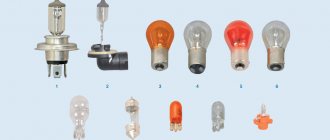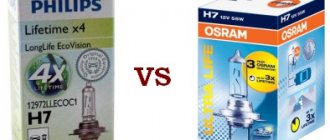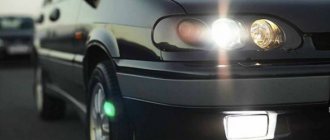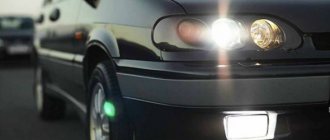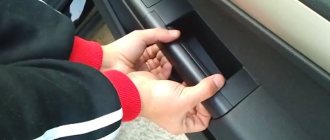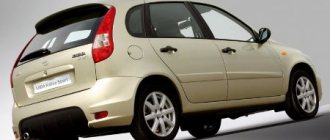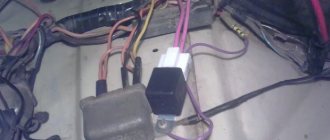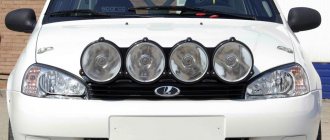If you can’t wait to find out right away which types of headlights are suitable for installing xenon (xenon light bulbs are called gas-discharge light bulbs in a professional environment), then briefly, the headlights should have one of the following markings:
- DC/DR - means that this headlight is equipped with separate lamps for low and high beam, and xenon can be installed in either (both) of them
- DCR means that the headlight is equipped with one lamp, which can be used for both low and high beam (dual-mode headlight), and xenon can be installed in such a headlight.
- DC/HR - means that you can install xenon exclusively in the low beam, but in the high beam - it is prohibited.
- HC/HR - installed exclusively in Japanese car models and means that xenon operation of such a headlight is possible. But European cars may have the same marking, which means that the headlight can only be used with halogen lamps for both low and high beams, that is, in the latter case, installing xenon in such lamps is prohibited.
The given list of four possible headlight markings stipulates that if only such markings are available, it is possible to install xenon in a car’s lighting fixtures. There will be a number of abbreviations on the headlight of your car, among which you just need to find those indicated to resolve the issue of the possibility of installing xenon.
Now let's look at the marking options in which the installation of xenon is prohibited :
- HC/HR - means that this headlight is designed only for halogen lamps (separate lamps for low and high beam) in European cars (see list above).
- HCR - means that the headlight is equipped with one lamp that operates in two modes: for low beam and for high beam. Installing xenon in it is also prohibited.
- CR - means that only incandescent lamps (not halogen or xenon) can be installed in the headlights.
Where can I find the headlight markings?
Most often, on most cars, the headlight markings can be found directly on the glass part of the headlight, either on top of it (in which case you just need to open the hood) or on the back of it. However, on some car models, you will need to remove the headlight to find this marking.
Now let's look at a marked headlight as an example.
The number “1” means the type of headlight; the following types are distinguished:
- A - Side lights
- B - Fog lights
- C - Low beam headlights
- R - High beam headlights
- CR or C/R - Headlights for low and high beam
The number “2” means the type of lamps used in the headlight (a list of possible markings is given at the very beginning of the article)
The number “3” - the first letter means a mark of compliance with international standards (“E” - for European and Japanese cars, “SAE” or “DOT” - in American cars). The number next to the letter “E” indicates the country code of the headlight manufacturer.
The number “4” is the type of headlight intended for a certain direction of movement: right arrow - for countries with right-hand traffic, left arrow - for left-hand traffic, right and left arrows - for both driving options.
General information
If the headlights are not designed for xenon, then it will not be possible to install this type of lamp in them, since this is fraught with violation of the law and the issuance of a report from the traffic police inspector.
In addition, failure to comply with labeling requirements can lead to poor lighting quality, because headlights not intended for this purpose cannot ensure the normal operation of xenon and the concentration of the light emitted by it, which is necessary for the effective use of such lighting devices.
Marking is the designation of headlight features, expressed in letters and numbers, which tell the consumer what can be mounted in this optics so that it performs its tasks as efficiently as possible, without interfering with other motorists.
Marking is useful for craftsmen who immediately understand which lamps can be used in it and which additional devices may well be used to ensure operability.
Initial data
Different countries may have different labels that look the same but carry different information.
For example, in Japan the HC/HR marking is used - the same as in European cars, but if in an Asian country this means the headlight is suitable for xenon in low and high range modes, then in European cars such a designation will be a complete ban on xenon lamps and their intended purpose headlights are strictly for halogen lamps.
Therefore, if the car is Japanese, but is used in European countries, in particular in Russia, then you need to have with you certain documents explaining the meaning of the marking.
You should not ignore the markings on the headlights, because if its requirements are violated, you may not only not get high-quality light, but also dazzle other drivers, which is not only unpleasant, but also dangerous, since it creates an emergency situation and can provoke a real tragedy.
Their design
The glow of a headlight is created thanks to several specific elements, the most important of which is the light source itself in the form of a lamp, which shines in all directions, directing particles around itself.
The task of collecting light into a beam is taken care of by a reflector, which receives all the rays and directs them in a certain direction, amplifying them many times over.
At the same time, there is also a corrector for the xenon headlight, which limits the light zone, directing the beam forward.
There is also a difference in a xenon headlight, which is the actual absence of a diffuser; there is glass, but it is polished and does not have the functions that are needed, for example, for halogen or incandescent lamps, the light of which must be diffused for normal illumination.
The xenon lamps themselves are made in the form of a flask containing two electrodes, and its internal space itself is filled with a noble inert gas - xenon.
We recommend: When is it legal to install winter tires in 2019?
When the light bulbs are turned on, the ignition unit, which is located separately from the light bulb, is triggered and produces a voltage of 25 thousand volts through the wires, which enters the flask, and at the same time the gas begins to glow, and its light is directed in the desired direction using a corrector.
The legislative framework
Regarding xenon and compliance with labeling, there are Rules for the operation of vehicles, which regulate that the vehicle must use exactly those devices that are structurally provided for in it.
The same applies to individual technical elements, including headlights. Thus, when a headlight that is not intended for xenon and does not have the appropriate marking contains a xenon lamp, this is a violation of established standards.
But the 2021 law does not stipulate the marking of xenon on headlights, since this has not been adopted.
But a person who was noticed operating a car in which the lighting devices do not correspond to the markings or they were even replaced without coordination with the technical authorities of the traffic police risks being punished.
This is evidenced by the Code of Administrative Offenses of the Russian Federation and its Article 12.5, which even provides for deprivation of rights if the presence of light bulbs not intended for this device is proven by technical experts.
Xenon and the law
The issue of labeling needs to be looked at from the other side. Let’s say a person is stopped at a traffic police post, but the inspector is not aware of the designation of certain markings and issues a fine because they do not comply with GOST. What to do in this case? We will consider the issue of converting headlights to xenon below, but for now let’s consider the situation described.
In defense, you can show all the special documents that contain the marking data of the headlights. Any lamps for optics will have the same markings as headlights. It should be noted that the markings on car windows must also match the data indicated on the lamps. However, after this the inspector will not calm down, but will continue to issue a fine. Why? Marking headlights for KIA xenon is a rather complicated issue, so many people get caught using them illegally.
The fact is that the traffic police has a different system of standards, according to which a fine is issued in such a situation. Unfortunately, there is a document that regulates the installation of various optical devices on the machine. And the same document prohibits the use of certain parts, in this case optical instruments, in abnormal modes. This is exactly what the traffic police officer will issue a fine for.
This is interesting: Air filters for cars: how to change them yourself
In this case, the driver will think, why then are these light bulbs being sold? The answer is simple. This system must only be installed in suitable headlights. If the optics in a car are created with an emphasis on the use of halogen lamps, then no matter what the xenon label is, in any case their use is considered illegal. If there is a D symbol on the glass, then you can safely install xenon light. In this case, no one has the right to issue a fine, because the designation of the headlight is xenon, not halogen.
If you really want to use this type of optical system, but the car is not provided, then there is only one piece of advice. It is necessary to replace all the optics that are in the car with xenon ones. If such equipment is already available for a certain brand of car, then you can safely change the entire system. However, you need to understand that not all cars have a similar set.
Marking table for headlights for xenon and halogen
If we talk about ordinary light bulbs, the marking will have the following GOST abbreviation:
| WITH | low beam |
| R | high beam |
| CR | dual-mode |
The marking of a gas-discharge light source begins with the letter D, and the halogen filament begins with H.
If you want to install halogen or xenon bulbs, you must have the following markings on the headlights:
| Abbreviation | Decoding |
| Halogen lighting | |
| HC | low beam optics |
| HCR | Low and high beam lamp |
| HC/R | Low or high beam lamp |
| Xenon lighting | |
| DC | Low beam lamps |
| D.R. | High beam lamps |
| DC/R | Low or high beam lamps |
How to avoid deprivation of rights for xenon is explained in the article: deprivation of rights for xenon.
Read about the reasons why xenon lights up pink here.
Decoding
The first letter in the code indicates that the optics comply with the quality standard for a particular region.
The letter E indicates that the headlight meets the optical equipment standards adopted for European and Japanese cars.
SAE, DOT - indicates that the headlight meets the standard adopted by the American Technical Inspection for Automotive Optics in the United States.
The number after the first letter indicates the country of manufacture or the state that issued approval for the use of this class of optics. The approval certificate guarantees the safety of a specific model for use on public roads within the established modes (daytime running lights, high beam, low beam, etc.).
The table below provides a short list of country compliance.
| Code digit | A country | Code digit | A country |
| 1 | Germany | 12 | Austria |
| 2 | France | 16 | Norway |
| 3 | Italy | 17 | Finland |
| 4 | Netherlands | 18 | Denmark |
| 5 | Sweden | 20 | Poland |
| 7 | Hungary | 21 | Portugal |
| 8 | Czech | 22 | Russia |
| 9 | Spain | 25 | Croatia |
| 11 | Great Britain | 29 | Belarus |
In the international marking of automobile headlights, the following combinations of symbols are adopted, which determine the type and location of the headlight unit, lamp class, beam range, and flow power.
According to functionality and operating parameters, the optics are marked with the following symbols:
- A – head optics;
- B – fog lights;
- L – license plate illumination;
- C – headlight for low beam bulbs;
- RL – daytime running lights;
- R – block for high beam lamps.
If the headlight unit fits universal lamps with built-in switching for high/low beam, the following combinations are used in the code:
- HR – high beam must be provided by a halogen lamp.
- HC/HR – the headlight is designed for halogens, the unit has two modules (sockets) for low and high beam lamps. If this HC/HR marking is used on a headlight from a Japanese manufacturer, then it can be converted to use xenon lamps.
International marking designation
The lighting equipment of any wheeled vehicle must be marked with an alphabetic or digital code. All auxiliary elements - ignition blockers, correctors, lenses, diffusers - are marked with certified markings in accordance with international standards 41.99-99.
The code must meet the following parameters:
- be clear, easy to read;
- be in a visible place;
- have comprehensive information about the manufacturer, the angle of the light beam, certification;
- contain a designation whose arrows indicate the month and year of production.
With the help of decoding, you can determine whether car optics were changed due to a serious accident.
International approval mark
Optical instruments from different countries differ in luminous flux, as well as in the direction of the cut-off angle. The necessary information is contained on the optics body in the form of a sticker or molding on plastic.
In the classic version, optics are marked with five main designations:
- headlight type;
- used lighting elements;
- region-specific compliance;
- intended for different directions of movement;
- manufacturer.
Manufacturers apply technical information to the bottom edge of the glass. You do not need to open the hood to view the necessary information.
LED headlights. Is it possible to bet?
Let's figure out what LED headlights are, whether they can be installed in standard headlights, and how traffic police inspectors feel about all this.
Marking of headlights for possible installation of LED lamps
| The Definitions section (Section II) of the Technical Regulations provides the basic designations for marking all types of high and low beam headlights: headlights with halogen lamps are designated by combinations of English letters H.R., H.C. or HCR, where type HR denotes low beam devices, HC - distant, and the designation HCR means a dual-mode (near/far) light source; headlights with traditional incandescent lamps are marked with letters like R,C or CR; gas discharge (xenon) headlights are designated by abbreviations DR, DC or DCR. The Technical Regulations also indicate the designation of fog lights - type IN or F3. One of the features of using headlights with LEDs is the fact that the Technical Regulations do not have a designation for LED light sources as such , and manufacturers, in their designations of factory-installed headlights, label such devices as halogen. The validity of such markings for LED headlights is confirmed by communication with traffic police inspectors, who clearly equate lighting devices with LED lamps to halogen light sources. |
Installing LED lamps in halogen headlights
Now let's move directly to the issue of installing LED lamps in halogen headlights and possible liability for such actions.
The process of installing lighting devices itself is not technically difficult, but it conflicts with the List of faults prohibiting the operation of vehicles, paragraph 3.1 of which reads: 3.1. The number, type, color, location and operating mode of external lighting devices do not meet the requirements of the vehicle design. Note. On discontinued vehicles, it is permitted to install external lighting devices from vehicles of other makes and models.
The situation is explained by the fact that a lamp based on light-emitting diodes differs slightly in light characteristics from a halogen lamp, and its use with halogen-optimized reflectors violates the operating mode of the lighting device, as indicated in paragraph 3.1.
In practice, replacing halogen with LEDs does not produce such negative differences as, for example, replacing with xenon lamps. When installing xenon lamps instead of halogen ones, the cut-off line is very blurred, and sometimes it is even difficult to determine. Therefore, xenon lamps are easily identified by traffic police officers.
As a result, we can formulate the conclusion that the reflectors of halogen headlights with LED lamps practically do not distort the light characteristics, as happens with xenon.
Penalty for installing LED lamps in headlights
Driving a vehicle with LED lamps in halogen headlights entails an administrative fine of 500 rubles. The amount of the fine is established for driving a vehicle in the presence of malfunctions under paragraph 1 of Article 12.5 of the Code of Administrative Offenses (CAO): 1. Driving a vehicle in the presence of malfunctions or conditions under which, in accordance with the “Basic provisions for the admission of vehicles to operation and the duties of officials persons for ensuring road safety”, operation of the vehicle is prohibited, with the exception of malfunctions and conditions specified in parts 2 - 7 of this article, entails a warning or the imposition of an administrative fine in the amount of five hundred rubles.
In practice, traffic police inspectors and courts try to hold the driver accountable under paragraph 3, article 12.5 of the Code of Administrative Offenses: 3. Driving a vehicle on the front of which there are light devices with red lights or red reflective devices, as well as light devices, the color of the lights. and the operating mode of which does not comply with the requirements of the “Basic provisions for the admission of vehicles to operation and the duties of officials to ensure road safety” - entails deprivation of the right to drive vehicles for a period of six months to one year with confiscation of the specified devices and accessories.
From the above text we can conclude that the punishment under this article looks like a real deprivation of rights for a serious period of 6 to 12 months. The mistake of law enforcement officers lies in the free interpretation of the necessary combination of two conditions (the color of the light signals and the operating mode), and the punishment in the form of deprivation of rights follows only one point - violation of the operating mode. This follows from the fact that LED headlights do not interfere with the color of the lights, which by law can be white, orange or yellow. But even the deprivation of rights for the mode of operation does not seem legally correct, since the discrepancy between the type of lamp and the marking of the headlight is not a violation of the mode, which by law is interpreted only as constant or flashing.
The real situation with LED lamps in headlights
The real situation with the punishment of vehicle drivers for LED lamps in halogen lighting devices is that proving the very fact of a violation poses considerable difficulty for traffic police officers, which is determined by a number of factors: according to internal documents of the Ministry of Internal Affairs, control over the technical characteristics of headlights can only be carried out by inspector of technical services and only at equipped stationary technical diagnostic points of the traffic police. Diagnostic tools must be registered in the state register; The inspector conducts an external inspection at the place where the car is stopped without opening the hood, and access to the engine compartment is already called an inspection and requires the presence of two witnesses or the use of video recording; even if there are witnesses and the condition of the engine compartment is recorded, opening or disassembling the headlights is not allowed, as this leads to a violation of paragraph 1 of Article 27.9 of the Code of Administrative Offenses: 1. Inspection of a vehicle of any kind, that is, an inspection of a vehicle carried out without violating its structural integrity, carried out in order to detect instruments or objects of an administrative offense.
A particular difficulty in diagnosing the presence of low-beam or high-beam LED lamps in halogen devices is that the light and technical parameters of LEDs are in many respects practically no different from halogen light sources. The universal nature of LEDs lies in the fact that the LED manufacturer can easily reproduce any parameters of halogen lamps - brightness, luminous flux or color temperature. A complex algorithm for detecting and proving the presence of LEDs in halogen headlights leads to the fact that traffic police officers prefer not to touch owners of headlights with LED lamps , except in cases of outright violation.
Continue
Jungar-kz › Blog › Headlight markings (halogen, xenon)
C - low beam, R - high beam, CR - dual-mode (low and high beam) light with incandescent lamps (UNECE Rules No. 112, GOST R 41.112-2005); HC - low beam, HR - high beam, HСR - dual-mode light with halogen incandescent lamps (UNECE Rules No. 112, GOST R 41.112-2005); DC - low beam, DR - high beam, DСR - dual-mode light with gas-discharge light sources (UNECE Rules No. 98, GOST R 41.98-99).
International designation for headlight markings C – low beam R – high beam H – only with halogen headlight HCR – low and high beam with halogen bulb DC – low beam xenon DCR – high and low beam xenon PL – plastic lens S – headlight lamp (all glass) B – fog light A – side light
HC: Halogen low beam HCR: Halogen low and high beam HC/R: Halogen low and high beam
Headlight markings for xenon DC: Xenon low beam DR: Xenon high beam DC/R: Xenon low or high beam
If there is an arrow on the headlight, then such a headlight is used specifically for left-hand traffic, and without an arrow for right-hand traffic. And if the arrow is on both sides, then it can be used for left- and right-hand traffic.
Each vehicle must have the starting low beam angle indicated on the headlamp housing, or on a special plate under the hood, or on a general nameplate. Typically the starting angle is 1.0-1.5%! There must be a tilt angle corrector, since when the car is loaded, the initial angle changes.
The brake signal is designated S1 (red). The tail light signal is indicated by R (red). The general designation of the lamp for signal and size is R-S1. The additional brake light is designated S3 (red). Designation of the front turn signal 1, 1b, 5 - side, 2a - rear (they emit orange light). Turn signals also come in a transparent color (white light), but they shine orange due to the orange lamps inside.
Cars that are designed specifically for the North American market do not have European lighting markings. The turn indicators on the “Americans” are red, but there are other combinations, for example, orange, and the rear ones are red. Canadian models have orange turn signals, but no side turn signals. They also don't have fog lights, which are mandatory in Europe. Retroreflectors are designated IA. The side reflectors are orange. The rear license plate light is designated L. Side marker lights are required on long vehicles over 6 meters in length. They have an orange light and the designation SM1 and SM2 (for passenger cars). And for the rear there is a red light. On trailers it is necessary to install a triangular reflector, designated IIIA, and contour lights.
We recommend: Symptoms of a faulty oxygen sensor
The letter “E” is followed by the number of the country in which the headlights were approved.
Below is a breakdown of the main countries that approve automotive optics:
1. Germany, 2. France, 3. Italy, 4. Netherlands, 5. Sweden, 6. Belgium, 7. Hungary, 8. Czech Republic, 9. Spain, 10. Yugoslavia, 11. Great Britain, 12. Austria, 13. Luxembourg, 14. Switzerland, 16. Norway, 17. Finland, 18. Denmark, 19. Romania, 20. Poland, 21. Portugal, 23. Greece
How to correctly decipher the markings
The easiest way to figure it out is the diagram; the layout is always the same. This applies to both the main headlights and fog lights, tail lights, turn signals and other lighting equipment, if any.
What does the marking mean?
For simplicity and clarity, a diagram indicating the location of different groups of data is first given. Below there are explanations in order to quickly understand and find out all the necessary data about the equipment.
This is a standard option that can be found on almost all headlights and lanterns.
The international approval mark, indicated by the number “1,” tells you in which region the headlights or lanterns are certified. The most common options are:
- E – Europe.
- DOT - USA.
- SAE is the Association of Automotive Engineers.
Next to the letter code is a number that indicates the country that issued the certificate. Here are the main options:
- Germany.
- France.
- Italy.
- Netherlands.
- Sweden.
- Belgium.
- Hungary.
- Czech Republic.
- Spain
- Yugoslavia (all former countries).
- Britannia
- Austria.
- Poland.
- Portugal.
- Russia
These are the main manufacturing countries. Often there is a manufacturer's logo on the case, especially if the brand is well-known. Also, to keep things simple, many people mark the country of manufacture so as not to have to deal with codes.
The code number 2 shows the purpose of the headlight. There may be several options:
- A – front marker or side lights.
- L – rear license plate illumination element.
- R – rear dimensions.
- B – front fog lights.
- F – rear fog lights.
These are the most common options used in labeling.
The number “3” indicates the type of lamp that is installed in the equipment. This aspect is discussed in detail in the next chapter.
The number “4” tells you what type of lamps should be used. Thus, the DCR marking means that xenon bulbs can be installed for both high and low beam.
Under the number “5” in the diagram is the leading main number or VOC, which shows the intensity of low and high beam lighting. It’s simple – the higher the indicators, the brighter the light the equipment can produce. Such information is applied only to headlights that have low and high beams.
Manufacturers are prohibited from making headlights with a VOC higher than 50 (150,000 candelas), and the total indicator must be no more than 75.
The number "6" usually represents arrowheads. They tell you what kind of movement the light source is intended for. If the arrow is directed to the left - for left-handed, to the right - for right-handed. When there are both arrows, then you can use headlights on roads with different directions of movement, but in this case it is necessary to adjust the equipment to adjust the luminous flux. If there are no markings, then the headlight (and this marking is applicable only for headlights) is intended for right-hand traffic, which is what is most common in the world.
If there is a marking on the case, shown in the diagram with the number “7” , this indicates that the equipment uses diffusers made of polymer materials.
The symbol under the number “8”, if present, indicates that a reflector is used in the design.
The number “9” is intended for specialists in car repair shops and shows the angles of inclination that should be used when adjusting the light. They use data to simplify and speed up the process.
Some manufacturers apply markings to the outside of the headlight.
The number “10” informs about the standards to which a particular product meets. These can be both international standards and their own or regional variants. The second line usually reflects the homologation number (improvement to improve performance).
Video: Where to look for the headlight number.
What headlight markings should be for installing xenon
If the headlights are marked with the first letter H or C, then the use of xenon in them is strictly prohibited, since they can only provide for the operation of halogen and, accordingly, incandescent lamps.
But so that xenon can be placed in the headlights without violations, markings with the letter D are used.
For example, DC means that the headlight can use xenon low beam, and if the marking is DR, then we are talking about the possibility of using xenon high beam.
In addition, there are headlights that are prudently designed for one light bulb that operates in two modes at once - low and high.
For xenon, this marking is designated as DCR, and if such letters are on the headlight, then gas-discharge type light sources can be used in it.
Thus, attention should be paid to the first letter of the marking, and if it is D, then using xenon in such headlights will be completely legal.
And the driver should always check the labeling before using a particular light technology.
How to choose the right lamps
To choose xenon lamps, you must first pay attention to the type of base used in it.
The most popular types are h3, h7 and others, and even if the name is multi-character, only the first letters have meaning, and they will indicate the required type.
In addition, you can choose a base based on the car’s headlight itself, and also read about it in the car’s service book if it has standard headlights.
In addition, xenon lamps differ in color temperature:
| 3500 K | They emit a yellow color that is similar to halogen, but brighter and more intense, so it can be used, but mostly in fog lights |
| 4300 K | Most similar to daylight sunlight, with a slightly noticeable yellow tint giving a milky appearance. They are considered the most preferable for public roads, since they illuminate both the road and the side of the road, therefore they are often installed in factory settings |
| 5000 K | They have a bright white color without impurities, but are used more often by developers of non-standard xenon |
| 6000 K | They have a cool white tone, diluted with a blue tint, so they are ideal for dry roads |
| 7000 K or more | The bluish glow increases, then turning into violet; such lamps are not productive for everyday use, since they do not provide sufficient visibility |
Where do manufacturers put it?
Typically, markings are applied by headlight manufacturers on the outer glass part of the headlights, and can also be found on the top of the housing or even at the rear, which can only be discovered by examining the engine compartment.
To find it there, you just need to open the hood, but there are situations when to find the marking you need to disassemble the headlight and even remove it.
In addition, there may be other designations, for example, the type of headlights, where A means side lights, B means fog lights, C means low or high beam, and dual-mode optics is designated as a combination of two letters, or their use through a dividing strip.
Which xenon shines better, 4300 or 5000, see the article: which xenon is better than 4300 or 5000.
How much it costs to restore your rights, read here.
Further, there may be a marking of compliance with international standards. So, the letter E means that the headlight can be used in Japan and Europe, including the CIS, and for American vehicles there are SAE or DOT designations, next to them there is a number that indicates a specific country or region, for example, Russia is part of the CIS therefore, for it and other Commonwealth countries the code E22 will apply.
Correct headlights have an arrow that indicates the direction of travel for which the headlight is used, for example, a mark pointing to the right means use for countries with right-hand traffic.
What is the difference between this type and halogen
Xenon headlights have replaced halogen headlights and are of better quality.
Thus, xenon light, unlike halogen, is similar to daylight, while halogen options shine yellow, which is not natural and tires the driver’s eyes faster.
Halogen light, like incandescent lamps, is scattered due to the design of the corresponding headlights, while xenon light, on the contrary, is collected into a beam, which is facilitated by the lenses installed in the headlights; the boundary of such light is quite clear, which makes it possible to regulate it and thereby prevent driver dazzle.
Xenon headlights last much longer, on average about 3000 hours, while halogen headlights can only provide 500 hours, and it is in this sense that they are not reliable.
The design of these two types also differs, because while xenon lighting uses a bulb with pumped gas, halogen headlights work thanks to the good old filament coil.
We recommend: Rating of the best sealants for car headlights in 2019
Which lamps can be marked?
You can put the xenon mark on any lamps that were produced taking into account technical regulations and requirements for the design of such lamps, and also comply with generally accepted parameters.
At the same time, you can’t put a xenon mark on any headlight; it must have ignition units, a certain design of the headlight itself, which does not scatter, but collects light into a beam, as well as lenses, but they are not always found.
In addition, it is the mark on the possibility of installing xenon that will prove to the traffic police inspector that the light bulb is installed legally, if this information coincides with the technical documentation of the car.
Sometimes research can be done on the headlight itself to see if it is actually designed to handle that kind of light, but this is only done by technical experts.
Video: car headlights xenon or halogen
Is it possible to redo it (change it)
It is impossible to remake a xenon headlight, and if there is a need to install a different light, then you should obtain permission to change the optics through the traffic police and independent experts, and only after that carry out all the necessary work.
But some craftsmen install xenon lamps in halogen headlights, which do not give the required result, since the light is scattered, and the xenon, which should be collected in a beam, simply does not work properly and can only blind other road users.
Driver tricks
If the driver uses xenon lamps installed in inappropriate equipment, then he must remember that he can agree to open the hood to check the markings only if there are two witnesses, and he cannot do anything on his own.
Moreover, if it was not possible to check, but the inspector wants to draw up a report, then this will not be a legal decision, since the presence of xenon should only be established in technical centers or licensed car repair shops in the presence of experts.
These tips will help you avoid punishment if the policeman does not follow the required instructions, but marking headlights for xenon with your own hands will not help, since an expert, if there is one, will immediately see the design differences, but if he is not there, then stickers with xenon markings will help, which are very similar to the original marks.
Find out how to check your driver’s license using the traffic police database for free from the article: check your driver’s license using the traffic police database online.
The marking of xenon headlights plays a big role, as it gives an understanding of whether the corresponding lamps can be used in them, and for which countries they can be used.
It is by marking that the police inspector will check whether xenon lamps are installed legally, but he can only do this if the inspection is carried out in a center technically adapted for this.
Markings applied to xenon lamps
Many car enthusiasts are confident that the quality of xenon lamps is much higher than that of halogen lamps. And that the light they emit is not so tiring for the driver's eyes. And this is true, since fluctuations in color temperature (a characteristic that reflects the intensity of radiation from a specific light source, in terms of a function of wavelength) for xenon lamps range from 4300 K (4027 ° C), which corresponds to the yellow color, to 8500 K (8227 ° C) , and this is the level of lilac-violet color. Both colors allow you to see the road better, which naturally reduces the strain on the driver’s eyes.
Xenon headlights come in single-lamp and two-lamp types, as evidenced by the corresponding markings on them. The presence of the DC combination on a xenon lamp indicates that it is used for low beam, while the letters DR are applied to high beam lamps. If the lamp is used in both high beam and low beam modes, then the DC/R marking is applied to its surface.
If there is an arrow on a xenon lamp, then it is intended for use on cars driving on the left, and its absence, accordingly, is for use on the right. In cases where the lamp can be used for any movement, two arrows are applied to its surface at once.
How are headlights marked by purpose?
Any car enthusiast knows that cameras in headlights have an optical system. There are separately installed high and low beams. On sale you can find a combined system that combines two types of light in one housing. Let's look at the markings of headlights for xenon and halogen.
Low beam headlight – “C”, high beam – “R”. The combined system is designated "CR". Side lights - “A”, fog lights - “B”. In addition, there are markings according to features and purpose, and there are also other signs that can encrypt interesting data for car enthusiasts. For example, the letters that represent the purpose of the light source with which the headlights work are very interesting. The international designation is the letter written in a circle. This sign contains the code of the country in which the headlights were authorized to be used. Quite often such elements are found on the headlight body or on a part such as a lens.
This is interesting: Rating of the best models of lamps for fog lights
Often, the marking of a headlight for xenon represents special data that you can find out, for example, about how harmful the lamps are. It should be noted that in America optics are marked DOT. Moreover, such encoding indicates the level of illumination in lux, and in the form of an arrow indicates the direction of movement. If the headlight is installed on left-hand drive cars, then the arrow will not be drawn. It is not available on right-hand drive vehicles either. If there are arrows in both directions, then this device is universal.
If you look at the marking symbols, you can even find out where this headlight was manufactured. Similar data is located on the inside of the glass. Glass markings may also be under the hood. As a rule, it is very difficult to search for such data in a car. To do this you need to remove the optics. The marking of headlights for xenon type GOST implies the designation of the angle of inclination for low beam. As a rule, this figure does not exceed 1%. This data must be indicated on stickers in the headlights.
Headlight type
In addition to their purpose, lighting devices can also differ in design. To find out these details, look again at the markings in the headlights:
- PL – diffuser made of plastic;
- S – all-glass headlight.
If there is an arrow in the headlight marking, then the device is intended for countries with left-hand traffic. If there is no arrow - for right-hand drive. If the arrow is double, then the lamp is suitable for both right-hand and left-hand traffic. The photo below shows a headlight for right-hand traffic on the left, a headlight for left-hand traffic in the center and a universal one on the right.
Important! Under no circumstances should you use headlights designed for another type of traffic - their cut-off line will be shifted to the oncoming lane and will blind drivers of oncoming cars.
Marking of headlights by light source
There are two most popular types of optical systems. We are talking about halogen and xenon lamps. The first type is considered standard and already familiar to everyone. It is designated by the letter H. This light is sold in different versions. As a rule, the diffuser must be marked with this symbol, regardless of its modification. For high beams, HR markings are usually used, and for low beams, HC. The halogen version is considered the safest; it does not blind drivers. Lamps of this type are reliable and do not burn out for a long time. Moreover, they are cheaper compared to xenon lenses.
International approval marks
The international approval mark consists of the letter E and one or two numbers in a circle. The numbers indicate the country that issued approval for this particular lighting device. It is quite obvious that the number must correspond to the country in which the headlight is used. We can see the decoding of country codes in the table below:
Decoding the codes of countries for international approval of automotive lighting devices
| Code | A country | Code | A country |
| 1 | Germany | 18 | Denmark |
| 2 | France | 19 | Romania |
| 3 | Italy | 20 | Poland |
| 4 | Netherlands | 21 | Portugal |
| 5 | Sweden | 22 | Russian Federation (complies with GOST) |
| 6 | Belgium | 23 | Greece |
| 7 | Hungary | 24 | not assigned |
| 8 | Czech Republic | 25 | Croatia |
| 9 | Spain | 26 | Slovenia |
| 10 | Yugoslavia | 27 | Slovakia |
| 11 | United Kingdom | 28 | Belarus |
| 12 | Austria | 29 | Estonia |
| 13 | Luxembourg | 30 | not assigned |
| 14 | Switzerland | 31 | Bosnia and Herzegovina |
| 15 | not assigned | 32-36, 38, 39 | not assigned |
| 16 | Norway | 37 | Türkiye |
| 17 | Finland | 40 | former Yugoslav Republic of Macedonia |
Instead of the letter “E” and numbers, the circle may contain the inscription DOT. This is an abbreviation for the Department of Transport (Department of Transport), and this marking refers to the United States of America.
Violations
Car owners are required and required to strictly adhere to factory markings and avoid any combination of incompatible items.
For example, if a car owner decides to install xenon equipment in conventional headlights without the DR, DC and DCR markings on them, this could be a threat to road safety.
Until September 23, 2010, when the technical regulations were adopted, non-compliance of headlights and light bulbs provided for an administrative violation in which the car owner could be deprived of his driver’s license from six months to a year, and the lighting equipment was confiscated.
A little later, changes were made that allowed the use of headlights without appropriate markings for xenon and halogen, but with mandatory equipment such as headlight washers and automatic headlight angle correction.
Failure to match the markings with the installed headlights is considered non-compliance with traffic rules and is punishable by the legislation of the Russian Federation.
If halogen or xenon lamps are installed in headlights designed for conventional (incandescent) light bulbs, the operation of individual vehicle devices may be disrupted.
The administrative punishment provided for this violation is regulated in the resolution of the Supreme Court of the Russian Federation dated December 15, 2009, number 11 AF09-1246.
An administrative case is initiated on the basis of Part 1 of Article 12.4 of the Code of Administrative Offences. It turns out that the use of vehicles with such violations is prohibited by law.
Are LED headlights allowed?
As follows from Russian legislation, LED lamps can only be installed in headlights of a certain type. The technical regulations of our country describe several types of front lighting devices:
- Xenon headlights.
- "Halogen".
- Incandescent lamps.
- Fog lights.
Each type has a specific marking.
Headlight markings for LED lamps
The marking of headlights is regulated by the technical regulations of the Customs Union, which provide the following definitions.
- Incandescent lamps. R – means low beam, C – high beam, CR – headlights that operate in both modes (often used in economy class).
- Fog lights. Designated as F3 or B
- Halogen lamps. HR – marking of low beam lamps, HC – high beam, HCR – simultaneous mode.
- Xenon headlights. DR is a sign for low beam, DC is for high beam, DCR means work in both versions.
The regulations do not say a word about the type of lighting device that is suitable for LED lighting. However, in practice, all traffic police officers and traffic authorities say that the appropriate type of headlights for LED lamps are halogen. Why exactly this is so is not entirely clear.
More on the topic: What awaits the driver for using special signals on a car: fines and deprivation of rights
In other words, LED devices can only be installed in those headlights that are marked as halogen lamps - HR, HC and HCR. It is in this case that your actions will be considered legal.
Additional Installation Requirements
In addition to the fact that LED lamps can only be installed on headlights with the required markings, they are subject to other requirements that are established by the same technical regulations.
The first requirement is the correct headlight angle. It should be adjusted so that it does not dazzle other road users. The second requirement is that headlights must be equipped with a device for cleaning them. These rules also apply to all light sources whose luminous flux exceeds 2000 lumens.
Optics for xenon
The markings on xenon headlights consist of the following letters:
- DC;
- DR;
- DC/R.
The first letters D indicate the use of gas-discharge sources in conjunction with lenses or special reflectors.
It is not recommended to independently install xenon in foglights and headlights with codes HC, HR, HC/R. This can not only harm the car's wiring, but also damage the reflector. The use of xenon is also prohibited in taillights.
Anti-theft headlight markings
Like windshields, car headlight lenses are also marked with a so-called VIN code, the purpose of which is to identify a specific glass in order to minimize the risk of theft of the headlight. This is especially true for expensive foreign cars from world-famous manufacturers, the cost of headlights of which is quite high, and either there are no analogues or they also have a considerable price.
Typically, the VIN is engraved on the headlight housing. Identical information is entered into the technical documentation of the vehicle. Accordingly, when checking the vehicle configuration of a traffic police officer, if the code value does not match, they may have questions for the car owner.
The VIN code itself is a seventeen-digit code consisting of letters and numbers, and is assigned by the car manufacturer or the manufacturer of the headlight itself. This code is also duplicated in several places on the car body - in the cabin, on the nameplate under the hood, under the windshield. Therefore, when purchasing certain headlights, it is advisable to choose light sources on which the VIN code is clearly visible and all information about the product is known.
Type of light emitted
Typically, information about the type of light emitted is indicated somewhere in the immediate vicinity of the circled symbol. So, in addition to the above types of radiation (halogen, xenon, LED), there are also the following designations:
- Letter L. This designates the light sources for the rear license plate of a car.
- The letter A (sometimes combined with the letter D, which means that the homologation refers to a pair of headlights). The designation corresponds to front marker lamps or side lamps.
- The letter R (similarly, sometimes in combination with the letter D). This is the designation for the rear parking light.
- Combinations of characters S1, S2, S3 (similarly, with the letter D). This is how brake lights are designated.
- Letter B. This is how the front fog lights are designated (in Russian designation - PTF).
- Letter F. The designation corresponds to the rear fog lamp, which is mounted on cars, as well as towbars.
- Letter S. The designation corresponds to an all-glass headlamp.
- Designation of the front turn signal 1, 1B, 5 - side, 2a - rear (they emit orange light).
- Turn signals also come in a transparent color (white light), but they shine orange due to the orange lamps inside.
- AR symbol combination. This is how reversing lights installed on cars and trailers are marked.
- Letters RL. This is how fluorescent lamps are marked.
- Combination of letters PL. These symbols correspond to headlights with plastic lenses.
- 02A - this is how the sidelight (size) is designated.
It is interesting that cars intended for the North American market (United States of America, Canada) do not have the same designations as European ones, but they do have their own. For example, turn signals on American cars are usually red (although there are others). The symbol combinations IA, IIIA, IB, IIIB are reflectors. Symbol I corresponds to reflectors for motor vehicles, symbol III corresponds to towed devices, and symbol B corresponds to built-in headlights.
According to the rules, side marker lights must be installed on American cars longer than 6 meters. They are orange in color and designated SM1 and SM2 (for passenger cars). The rear lights emit a red light. On trailers it is necessary to install a triangular reflector, designated IIIA, and contour lights.
Often the information plate also contains information about the initial angle of inclination at which the low beam should be scattered. Most often it is within 1...1.5%. In this case, there must be a tilt angle corrector, since with different loads of the car, the angle of illumination of the headlights also changes (roughly speaking, when the rear of the car is heavily loaded, the main luminous flux from the headlights is directed not at the road, but directly in front of the car and even slightly upward ). In modern cars, as a rule, this is an electronic corrector, and they allow you to change the corresponding angle directly from the driver’s seat while driving. In older cars, this angle must be adjusted directly in the headlight.
Some headlights indicate the SAE or DOT standard number (European and American automaker standards).
